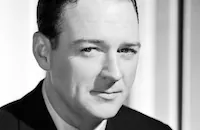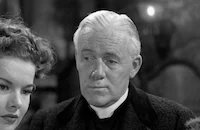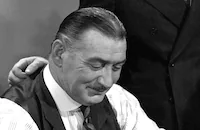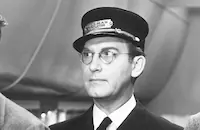Night Editor

Brief Synopsis
Cast & Crew
Henry Levin
William Gargan
Janis Carter
Jeff Donnell
Coulter Irwin
Charles D. Brown
Film Details
Technical Specs

Synopsis
At the offices of the New York Star , Johnny, a troubled young reporter, slumps despondently at his desk. Johnny's problems cause editor Crane Stewart to reminisce about another troubled young man he knew years earlier: Homicide detective Tony Cochrane dotes on his little son Doc, but is estranged from Martha, his unsophicsticated wife. Tony's estrangement arises from his love affair with Jill Merrill, a cold-hearted socialite. Although Tony has tried to break off their relationship, Jill keeps him ensnared with her sexual depravity. While passionately embracing at the beach one evening, Jill and Tony see a car stop along the road and hear a woman scream. When a man jumps out of the car and flees, Tony is about to give chase when Jill reminds him that his involvement would expose their illicit affair. Torn between his responsibility as an officer of the law and his desire to conceal his private life, Tony lets the man escape, even though he has beaten the woman to death in the car. The next day, Tony and his detective friend, Ole Strom, are assigned to investigate the woman's murder. The victim is identified as Elaine Blanchard, the daughter of a prominent family. At the beach, Capt. Lawrence notices a second set of tire prints in the sand and instructs Ole to make a plaster cast of the tracks, hoping that it will lead to the second car. On the list of Elaine's associates to be questioned, Tony is shocked to read the names of Jill and her husband Benjamin. After making sure that Martha will not be home for dinner, Tony returns to his garage that evening, and under cover of darkness, changes the tires on his car. The next day, Tony goes to the Merrills' house to question them. After Benjamin leaves for work, Tony charges Jill with knowing the identity of the murderer, but she refuses to divulge his name. In search of clues, Tony goes to Elaine's bank to review her canceled checks, and meets banker Douglas Loring, whom he recognizes as the man who ran from Elaine's car. After a harmless tramp is arrested for Elaine's murder, Tony begs Jill to testify that she saw Loring at the crime scene, but she refuses to cooperate. To obtain a set of Loring's fingerprints, Tony tricks him into signing a statement about Elaine and then pockets his pen. On the eve of the tramp's execution for Elaine's murder, Tony matches Loring's prints to the murderer's prints that were found in Elaine's car. After informing Jill that he has evidence that will incriminate Loring, Tony shows the fingerprints to Capt. Lawrence, who then takes them to District Attorney Halloran. Tony and the captain are stunned to find Loring at the district attorney's office, confessing that he spent the afternoon of the murder with Elaine, who was in love with him. When Loring claims that on the night of the murder he was at a movie theater with Jill, Jill conveniently arrives at Halloran's office to corroborate his alibi. After Halloran dismisses Tony's evidence, Tony, furious, accuses Jill of betraying him, and she sneers that she is having an affair with Loring. Conscious-stricken, Tony finally admits to Ole that he witnessed the murder. When Ole asserts that they need concrete proof, Tony remembers the discarded tires in his garage. Hurrying home, Tony reaffirms his love for Martha, and she embraces him in forgiveness. Tony, Ole and several police officers then proceed to the Merrill home, arriving in the midst of a party. Finding Jill alone in the kitchen, Tony arrests her, and as she reaches to caress him, she stabs him in the back with an ice pick. In shock, Tony escorts her to the waiting police, hands his badge to the captain and then collapses from his wound. Back in the present, after Stewart concludes his story, Johnny rises from his stupor and goes to the lobby of the newspaper building. When he speaks to Tony, the proprietor of the cigar stand, and learns that Tony's son Doc is a celebrated homicide detective, Johnny realizes that Tony was the subject of Stewart's cautionary tale and hurries home.

Director

Henry Levin
Cast

William Gargan

Janis Carter

Jeff Donnell
Coulter Irwin

Charles D. Brown
Paul E. Burns
Harry Shannon
Frank Wilcox
Robert Stevens

Roy Gordon
Michael Chapin
Robert Emmett Keane

Anthony Caruso

Edward Keane
Jack Davis
Lou Lubin
Charles Marsh
John Tyrell
Jimmy Lloyd
Murray Leonard
Douglas Wood
Johnny Calkins
Ronnie Ralph
Joseph Palma
William Kahn

Emmett Vogan
Jack Frack
Donald Kerr
Betty Hill
Frank Dae
Harry Tyler
Charles Wagenheim
Wally Rose
Ed Chandler
Vernon Dent
Herman Marks
Frank Mcclure
Cy Malis
Crew
Gert Anderson
Mischa Bakaleinikoff
James Crowe
Lambert Day
Richard Fantl
Burnett Guffey
Scott Littleton
Russell Malmgren
Vera Mikol
Robert Peterson
Ted Richmond
Hal Smith
Philip Tannura
Ivan Volkman
Edwin Wetzel

Film Details
Technical Specs

Articles
Night Editor (1956)

Night Editor (1956)
Cleo Moore, Janis Carter and Ida Lupino Are Among the Stars of Bad Girls of Film Noir, Vol. 2
Made at the height of the noir years, 1946's Night Editor is formatted to be the first of a series of "Night Editor" movies, all consisting of stories told over a card table by the night crew in a newspaper office. No sequels were made using this radio-show format, but the device was successfully adapted for Jules Dassin's classic noir The Naked City. The flashback tale of a guilty detective is solid noir material, but the framing story reduces it to a wholesome life lesson for a young reporter: extramarital affairs are poison.
Married Detective Tony Cochrane (William Gargan) is parked with his society girlfriend Jill Merrill (Janis Carter) when they witness the murder of a young woman. Jill prevents Tony from apprehending the killer, as the scandal will destroy his marriage, and possibly his career. Tony stands by helplessly while his friends on the force mistakenly arrest an innocent man for the crime. The detective identifies a bank executive as the guilty party but cannot interest the DA, who happens to be a personal friend of the accused. Tony then discovers that Jill is conniving to keep Tony's hands tied in the matter. With the innocent man about to be executed, Tony will have to do act swiftly to prevent a terrible miscarriage of justice ... for which he bears full responsibility.
Night Editor is a familiar tale of a policeman compromised by a wicked woman, in this case the beautiful and irredeemable Jill. Icy blonde Janis Carter is yet another fine noir actress granted few opportunities to show what she can do. She almost exclusively played duplicitous women, as in Framed, I Love Trouble and The Woman on Pier 13. Jill Merrill is a skilled manipulator of men. When we see her holding an ice pick near the finale, we know Tony's in big trouble.
Director Henry Levin generates some interest for Tony Cochrane's dilemma but beefy William Gargan plays the straying, dull-witted cop as easy prey and not particularly sympathetic. Burnett Guffey creates attractive images but the low-end Columbia production has a claustrophobic feel. Yet Night Editor remains an exemplary slice of noir: Janis Carter's dead-on classic femme fatale earns the movie a solid B+.
One Girl's Confession (1953) introduces DVD both to the obscure auteur Hugo Haas and his most notable leading lady, Cleo Moore. Czech emigré Haas was an accomplished writer, director and actor who won character parts in Hollywood films before beginning a strange cycle of sordid dramas about tarnished women and older men, usually played by himself. Although Haas' micro-budgeted films gained little initial attention beyond critical jabs at Ms. Moore's limited acting ability, they're due for rediscovery -- even the worst has a worthy plot twist or two.
Waitress Mary Adams (Cleo Moore) steals $25,000 from her employer, who cheated her father into an early grave. Although she refuses to give back the money, she serves only three years of her sentence and takes up a new waitressing job for immigrant gambler Dragomie Damitrof (Hugo Haas), who soon becomes a good friend. Mary wants to recover her buried loot to help Johnny, a local fisherman (Glenn Langan) but isn't sure who she should trust. Then Dragomie gambles away everything he owns, including his café. Mary sends her employer to dig up her money; when he returns he says he couldn't find it. When Mary sees Dragomie driving a new car and giving parties in a swank apartment, her only desire is revenge.
One Girl's Confession comes on as an exploitation quickie promising a "hot" performance by the sexy Moore, who has a habit of showing off her profile in tight sweaters. Noir fans will certainly remember Moore as a sultry dame interrogated by Robert Ryan in Nicholas Ray's classic On Dangerous Ground. The unhappy blonde is accustomed to being propositioned: "Men are all alike, their faces are just different so you can tell them apart." After a history of betrayal by men of all ages, Mary is a somewhat incompatible mix of disillusionment and naïveté. Although not the most expressive actress, Cleo Moore brings cold beauty and a warm smile to the role, and allows her performance to be shaped by director Haas in a sub-Sternbergian fashion.
Despite some gaping lapses in logic, the show shapes up as a morality tale in miniature, where even the moral is of no great consequence. Cleo Moore apparently lured enough lonely men into theaters, to merit her return in a series of Columbia films, including several more by Hugo Haas.
Cleo Moore is part of the ensemble cast of Women's Prison, which could be the template for 101 trashy babes-behind-bars epics to follow. In 1955 the concept was still associated with the classy Warners drama Caged. The mostly female cast is comprised of well-regarded star names, most of whom were probably freelancing after being cut loose by the crumbling studio system. In keeping with the antiseptic fifties, this brightly lit prison is clean and staffed with mostly sympathetic matrons. There's nothing wrong with the system, as the burden of villainy is carried by two bad-apple wardens.
Convicted for manslaughter by automobile, the already traumatized Helene Jensen (Phyllis Thaxter) becomes hysterical when subjected to the harsh solitary confinement given all new inmates at the women's prison. Only the intercession of kindly Doctor Crane (Howard Duff) prevents the sadistic women's warden Amelia van Zandt (Ida Lupino) from punishing Helene further. The more experienced inmates offer Helene protection: Brenda (Jan Sterling of Ace in the Hole), Mae (Cleo Moore) and Joan (Audrey Totter of Tension). Joan's husband Glen (Warren Stevens) is incarcerated just across a wall in the same facility, and is continually looking for excuses to cross to the other side to see her. Van Zandt continues to abuse the prisoners, and Dr. Crane can't get the do-nothing supervising warden Brock (Barry Kelley) to do anything about it. Glen's discovery of a way to sneak to the women's side results in Joan getting pregnant, which pushes van Zandt over the edge. When the inmates learn that Joan has been severely beaten, a cell block riot breaks out.
Women's Prison is also not a true noir but merely a spicy potboiler about caged women, where the only real steam comes from the pressing machines in the laundry room. The main characters are given fairly good dialogue, with saucy Jan Sterling afforded the best lines. Former MGM wartime sweetheart Phyllis Thaxter is reduced to screaming fits by the warden's perverted methods. Dr. Crane tells van Zandt to her face that she's a sexually frustrated psychopath, a scene that carries considerable camp value considering that Ms. Lupino was Mrs. Duff at the time. In contrast to later exploitation efforts, Women's Prison has no lesbian angle and no shower scenes; we instead get celebrity impersonations, and gospel songs from a group of black inmates led by Juanita Moore.
The impressively produced Over-Exposed (1956) wrings the most out of a tiny budget and benefits from a script that gives star Cleo Moore a real character to play. Although burdened with typical 1950s-era values -- no decent woman prefers a career over marriage -- the movie shapes up as satisfying entertainment.
Nightclub girl Lily Krenshka (Cleo Moore) is caught in a police raid but avoids being run out of town when the elderly photographer Max West (Raymond Greenleaf) takes her in. Lily helps Max kick his drinking habit and uses her B-Girl wiles to help him sell more photos; soon the studio is on its feet again and Lily has learned the photography trade. Under the new name Lila Crane, she goes to the big city and meets reporter Russell Bassett (Richard Crenna), who helps her make a sale or two. Taking a job as a photo girl in a restaurant, Lila works an angle between a columnist and a gangster to land a lucrative photo girl position at the fanciest eatery in town. Turning on the charm, she meets people who help make her a famous name with commercial clients and even a guest spot on a TV show. Lila turns down Russell's offer of an "honest" position as both his news photographer and his wife -- but gets in a tight spot with the criminal element that helped kick-start her career.
Over-Exposed is a great showcase for the underappreciated Cleo Moore, as her tramp-turned slick businesswoman shows her off in several modes -- the hard girl on the street, the perky model, the successful artist. Lila Crane uses the tricks she learned to hustle drinks to cajole smiles out of customers and cooperation from rich matrons. Her experience also comes in handy when negotiating with the powerful and the unscrupulous. Unlike Mildred Pierce, Lila is only after material success. If she were a man, her ambitions would be celebrated. The film makes an interesting statement about the economic liberation of women, at least until the conventional ending.
Although the film lacks impressive visuals and directorial touches, its leading lady is always attractively photographed. Much maligned as a Marilyn Monroe wanna-be, Ms. Moore is deserving of her cult status.
Sony's Bad Girls of Film Noir Volume 2 is another assemblage of pristine-quality transfers. The two newest B&W films are encoded in enhanced widescreen. Trailers have been located for every title save Night Editor. An additional extra is a 1954 Ford Television Theater show entitled Remember to Live. Cleo Moore plays to type as a cheap neighborhood vamp who distracts returning Korean War vet Dane Clark from the wholesome girl he really belongs with, Barbara Hale.
For more information about Bad Girls of Film Noir, Vol. 2, visit Sony Pictures. To order Bad Girls of Film Noir, Vol. 2, go to TCM Shopping.
by Glenn Erickson
Cleo Moore, Janis Carter and Ida Lupino Are Among the Stars of Bad Girls of Film Noir, Vol. 2
Quotes
Trivia
Notes
The working title of this film was Inside Story.














